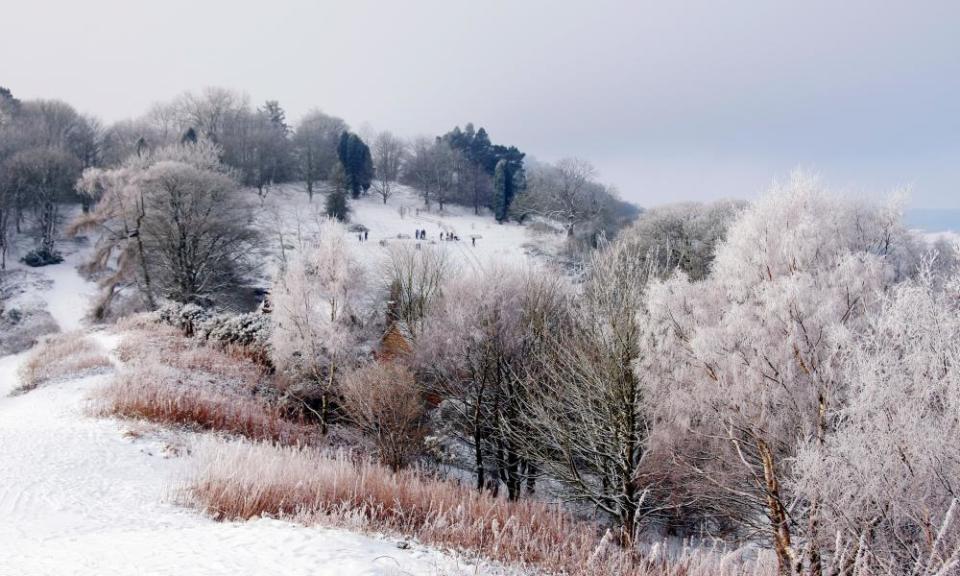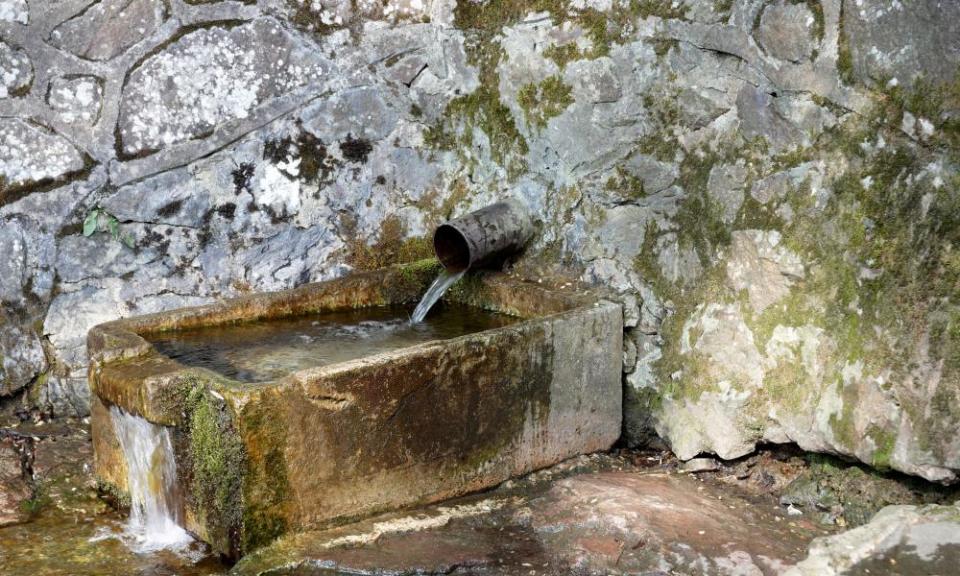Seeking solace in the hills: why the Malverns are perfect for walking

On the western slope of the Malvern Hills, along the border of Worcestershire and Herefordshire, there is a hairpin junction where a small lane leads downhill off the main road into the woods. It is common to see clusters of vehicles here, and if you stop to investigate you’ll find yourself among an ever-changing but faithful coterie, some of whom have travelled many miles. They are gathered around a spout in the side of the hill that gushes a constant stream of water, straight from the ancient rock. This is Evendine spring, one of more than 100 natural springs in the Malvern Hills, and according to the regulars, the finest-tasting of them all. Some of the visitors are drinking from cupped hands, most are filling plastic bottles, and the old lags are hauling multiple jerry cans into their vans. At weekends you may have to wait a while but the mood is always convivial, as if you’ve happened upon a secret society.

I first discovered Evendine spring during the 2020 winter lockdown. Floored by long Covid, I holed up with my husband in a cabin by the River Severn near Hanley Castle, with views of the Malvern Hills to the west. As part of my recovery, I was planning to walk a little further each day with the aim of making it up on to the ridgeline. There were routes to suit any mood or energy level, from twisty wooded trails to stony moorland tracks and even the “99 Steps”, a Victorian-built staircase. Although steep, none of these could be considered long walks, but this was all about tiny steps. The previous winter I had happily hiked across Egypt’s Sinai desert, so there was a certain amount of physical and emotional adjustment to be made to my newfound circumstances – from a life of action and adventure to struggling to walk and breathe. The Malverns seemed like ideal rehab hills – small but perfectly formed, sandwiched between the cities of Worcester and Hereford, running just eight miles north to south, with a maximum elevation of 425 metres.
My seeking solace in these hills was nothing new. There is evidence of human habitation dating back to the iron age, as well as bronze age burial mounds and ancient drovers’ tracks. By the 1850s the fashion for hydrotherapy saw visitors flock to Great Malvern, a classic Victorian spa town in the eastern foothills – all gabled villas and decorative bus shelters. The natural springs were developed into official tourist sites, housed in typically ornate buildings such as St Ann’s Well and Holy Well, which survive today. The town’s healing vibe remains strong: it has morphed into a well-heeled hippy hotspot of organic health food stores and alternative therapies.

But it’s the hills that keep drawing you back. Ever present, looming over the town, urging you to leave the prim Victoriana behind and ascend to higher things, to drink from the springs that flow from the Precambrian rock, and to gaze across the nation from the windswept ridge. Although diminutive in comparison with other British hills, the Malverns have a mountainous feel that belies their humble dimensions, bursting forth, steep and sudden from the otherwise flat, featureless Severn Plain. Approaching from the east is the British equivalent of crossing the midwest prairie and seeing the Rockies looming in the distance. Each week, as I extended my walks by a few minutes, it was this promise of elevation that got me outside, putting one foot in front other, trudging up slopes in all weathers, motivated by some primal urge to stand tall on high ground.

Approaching from the east is the equivalent of crossing the Midwest prairie and seeing the Rockies in the distance
In pre-Covid times I made annual trips to the Spanish Pyrenees, where one of the great pleasures is to drink from the fuentes, the spring water spouts in the mountain villages. With no foreign travel on the agenda, my Malvern treks became a scaled-down, pandemic-friendly version of these adventures: we’d walk the hills, seeking out the spots where water breaks through the ancient rock. The wells and springs of the Malverns range from nondescript depressions in the ground to pipes sticking out of stone walls to the elaborate Victorian structures and fountains. Some of the sources are easy to find – in the streets, formalised for public use, while others are hidden deep in forested slopes, just a trickle in a dell. Not all flow as freely as Evendine; a few have dried up over the years, or have been sealed off and are identifiable now only by tell-tale clues: an ancient brass tap in a wall or a weed-choked stone trough at the roadside.
My walks were gradually lengthening and my resolve was rewarded when a few days after Christmas (Zoom-heavy, alcohol-free), we awoke to a magical sight: snow had fallen on the Malvern Hills. This would be the day for the ridgeline. Along the sweeping curves of Jubilee Drive, the road that follows the contour of the hills’ western side, the branches of pine trees were bowed, heavy with fresh snow, in a scene that could have passed for the Alps. As I stepped out and started walking, the rare and thrilling crunch underfoot spurred me on. The slopes were alive with sledgers and dog walkers, families and solo hikers, everyone blinking and smiling at one another in the brightness and euphoria of a moment’s reprieve from the horrors of the past year.

The Malverns are a line of 22 hills, including the evocatively named Hangman’s, Tinkers and Perseverance. I chose the latter. Slowly, breathlessly, I made my way up its rocky path, until the ridge appeared in front of me and, with just one more step, like at the raising of a curtain, I found myself before a frosted panorama, pure white, stretching out across the Severn Valley to the distant Cotswolds. Behind me, to the west, the snow-covered Welsh Marches and the Black Mountains, also glistened under the wintry sun. The whole nation was sparkling in every direction.
They say that on a clear day you can see 13 counties and as far as 200 miles from the Malvern ridge. I have returned to this view in every season since – in the spring, when the bluebells and wild garlic carpet the slopes, and in summer when you share the hills with butterflies, a skylark if you’re lucky, and the dedicated hikers doing the “end to end”. Now the days are shorter, but the gold and amber of autumn brings a mellowness to a late-afternoon amble and the holly bushes are already dotted with berries. The Malverns may not be as expansive as the Brecon Beacons or as tickable as Snowdon, but they deliver everything you need from a hill walk: a sense of achievement and a higher perspective on whatever ails you.
They say on a clear day you can see 13 counties and as far as 200 miles from the Malvern ridge
Evendine spring flows all year round and I always make sure to stop by before setting off up the hills; there’s a fundamental pleasure in drinking water straight from the ground, as if tapping into some ancient knowledge. Local lore claims that it started with Saint Oswald, a first-century archbishop of York, who knew of Malvern water’s healing properties and revealed this to a hermit who lived in the hills. Centuries later, in the 1920s, Alfred Watkins, the Herefordshire antiquarian who theorised the idea of leylines, claimed to have discovered a line that connected a number of wells along the Malvern Hills. True or not, a reverence for the waters remains. On my last visit, its merits were being discussed with the language and veneration usually reserved for fine wines or craft beer.
“Hard … but also kind of sweet,” mused one of the jerry canners, who makes regular visits from Bristol. Another theorised that its flavour comes from the limestone that Evendine runs through, the only Malvern spring to do so.
“I won’t drink anything else,” he said. “There’s something magic about it. I don’t know what, but it does you the power of good.”
I fill my bottle and start walking up to the ridge. I think he might be on to something.

 Yahoo Movies
Yahoo Movies 